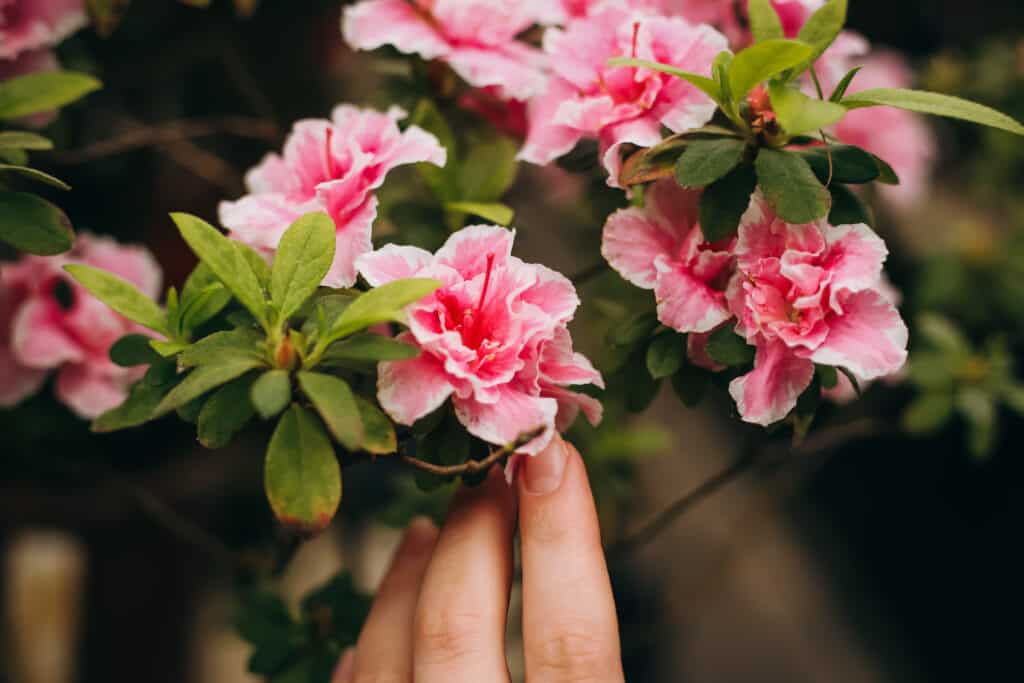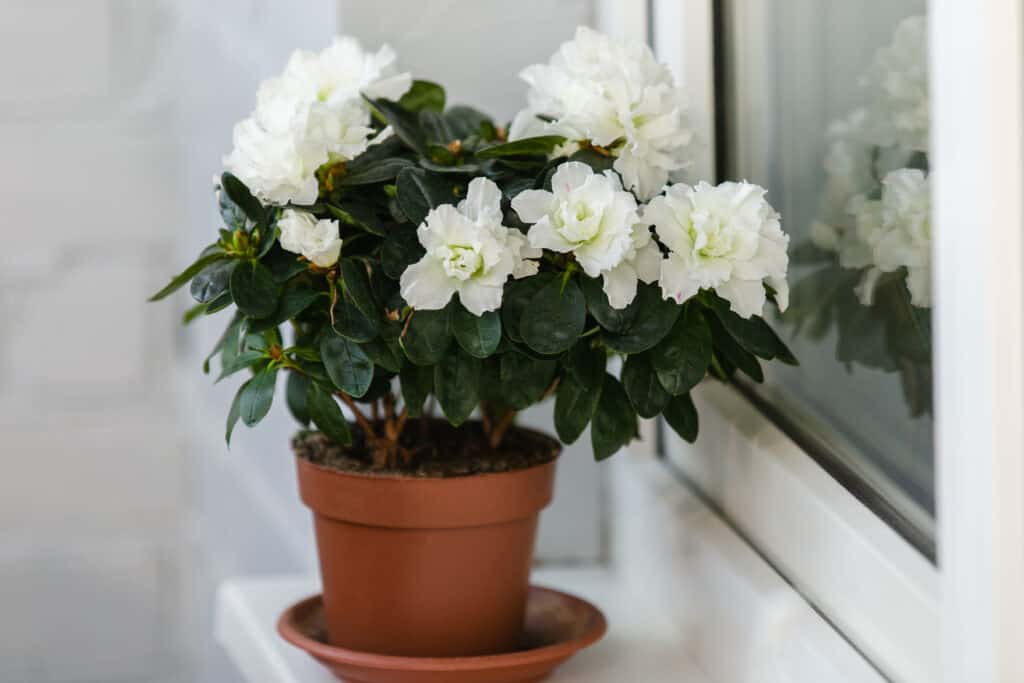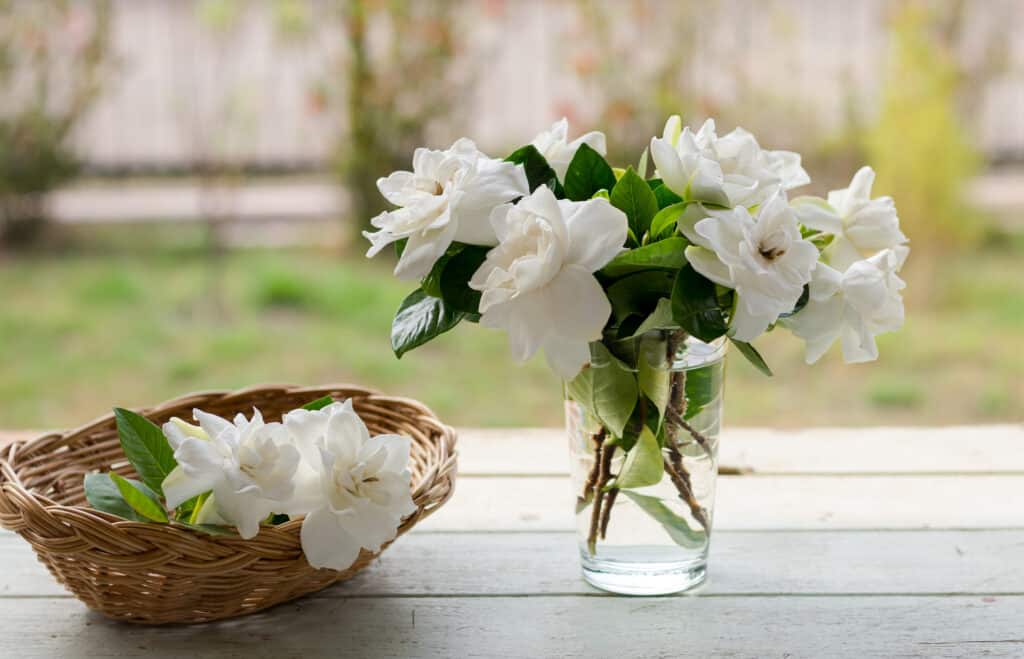The lovely gardenia is often confused with the azalea, as the white and yellow varieties do look very similar. They both have wonderful benefits, such as fragrant blooms, early spring flowers, and shiny dark green leaves. They are both a favorite food of ants and bees as temperatures warm up in the spring, making them a good choice for the insect conservationist. There are also quite a few differences, which we will discuss here.
Comparing Azalea to Gardenia:

Azaleas are most often used as foundation plantings for a splash of color.
©Anastasiia Immortal/Shutterstock.com
| Characteristic | Gardenia | Azalea |
|---|---|---|
| Scientific Name | Genus Rubiaceae | Genus Rhododendron Deciduous azaleas belong to the subgenus Pentanthera; Evergreen azaleas belong to the subgenus Tsutsusi. |
| Area of Origin | China and Japan | Japan and Korea |
| Size | Up to 8 feet tall and 5 feet wide | Wide range of sizes from 6 inches to 15 feet tall. |
| Shape | Oval shrub | Many shapes, from sprawling to oval shrub to vining varieties. |
| Time of flowering | Mid-Spring | Early Spring |
| Flower color | White or yellow | White, yellow, pink, orange, purple, fuscia |
| USDA hardiness zone | zone 7-11 | zone 4 |
| Sun or shade? | Part sun to full sun | Part shade |
| Flower description | 2-5 inch blooms. Single or double | Funnel-shaped, 2-lipped. 5-6 stamens. |
| Leaf description | Glossy dark green. Evergreen above zone 8. deciduous at colder temperatures | Soft pointed leaves. deciduous |
| Scented? | Strong scent, often used in perfume | Medium scent, also has unscented varieties. |
| Toxic? | Non-toxic, used in tea and wine | All parts of the plant are toxic |
| When to plant | Plant in fall or early spring | Plant in early fall or late spring |
| Soil requirements | Prefers acid soil, moist but well-draining with mulch | Prefers acid soil, moist but well-drained with mulch. |
Key Differences Between Gardenia and Azalea
The key differences between gardenias and azaleas are description, hardiness zone, toxicity, and flowers. Gardenias are classified differently from azaleas, belonging to a different plant family and genus. While there are several similarities, azaleas are most often used as foundation plantings for a splash of color, and gardenias are most often used as a large border plant due to their large size.
Let’s go over all of these differences in more detail now.
Gardenia vs. Azalea: Description

The gardenia grows only as a large ovular shrub.
©iStock.com/wichatsurin
At first glance, the gardenia and azalea can be hard to tell apart, especially if they both have white flowers. But there are a few easy ways to tell them apart.
The gardenia grows only as a large ovular shrub. The azalea can get large too, but most species you will find growing 2-3 feet and in a sprawling fashion. The gardenia only comes in a waxy white or pale yellow bloom, while the azalea can be bright white, bright yellow, pink, orange, or purple. If you see a pink or orange flower, it is definitely not a gardenia.
The leaves of the gardenia are very dark green and shiny. The azalea leaves are not shiny, soft, and pointy to the touch.
Gardenia vs. Azalea: Hardiness zone

Azalea prefers a partly shady environment with acidic, moist soil.
©irinacapel/Shutterstock.com
The gardenia is not cold tolerant. It likes a warm, sunny place in the garden with nice acidic soil of a 5.5 ph and moist, well-draining soil. It is hardy to USDA zones 7-11. If you are in zone 8+, the gardenia will be an evergreen shrub. If you are below zone 8, the gardenia will lose its leaves every year.
The azalea is a tougher cookie, enjoying darker, chillier climates. It prefers a partly shady environment with the same acidic, moist soil as the gardenia. The azalea is hardy to USDA zone 4 and is a fully deciduous shrub.
Gardenia vs. Azalea: Toxicity

Gardenias are often planted specifically for the large, strong-smelling blooms, which last a long time indoors after being picked.
©iStock.com/ANCHASA MITCHELL
The gardenia is fully edible, with the blooms often used as wedding cake decor, salad toppers, gourmet tea, and fine wine. Some people even make pickles out of green flower buds.
On the other hand, the azalea is fully toxic, with every part of the plant being poisonous. Bees that regularly dine on pollen from azaleas produce what is known as mad honey. Consuming the honey or any part of the azalea plant causes confusion, low blood pressure, and irregular heart rhythm. These symptoms could be life-threatening. Gardeners should take special caution with children or pets.
Gardenia vs. Azalea: Flowers

The azalea flower is rather delicate, with single petals arranged around 5 long stamens that damage easily.
©Witchitas/Shutterstock.com
The gardenia flower is large with either single or double petals. It is 2-5 inches across and lasts a long time in a vase. The double varieties look a lot like a rose flower. Gardenias are often planted specifically for the large, strong-smelling blooms, which last a long time indoors after being picked.
The azalea flower is rather delicate, with single petals arranged around 5 long stamens that damage easily. They last one day in a flower arrangement or centerpiece. Azaleas are planted with garden design in mind. They provide continuous spring color for the flower bed and are a welcome splash of pink or orange after a long gray winter.
Summary of Gardenia vs. Azalea

The gardenia plant does well in shaded areas and is non-toxic.
©Lapha.R/Shutterstock.com
As you can see, there are a lot of similarities as well as many differences. If you have small children or pets left alone in the garden, the non-toxic gardenia is the better choice. Azalea would be the best option if you are looking for a broader range of colors and sizes.
Another consideration is the growing requirements. If you don’t have a shady corner and need a flowering shrub that will receive full sun for at least 4 hours per day, the gardenia is the shrub for you. If you live in a northern climate that receives many hours of shade daily, you are looking for the azalea.
When selecting plants, size is certainly an issue. Suppose you have space for a gardenia that will grow to 10-15 feet tall by 5 feet wide, then you should definitely plant this strong-smelling show stopper. If you are looking for a plant that you can place in larger quantities along a foundation or island bed that will stay under 4 feet tall, the azalea will fit your design best.
NEXT UP…
- Rhododendron vs. Azalea: Is There a Difference? Are you considering the much larger rhododendron? This article will help you decide if the rhododendron is right for you.
- Is Azalea A Perennial Or Annual? Here are a few more details about the azalea.
- What Flowers Do Deer Not Eat? Are the wild creatures constantly eating your plants? This list will help you choose flowers that even the hungriest deer will not touch.
The photo featured at the top of this post is ©
Thank you for reading! Have some feedback for us? Contact the AZ Animals editorial team.






